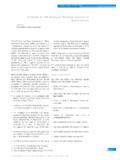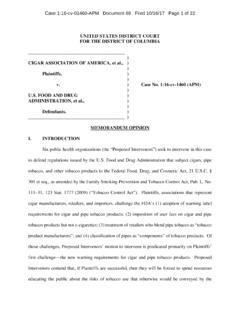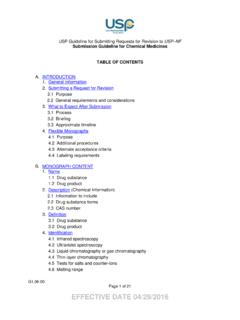Transcription of Science Moving towArds Research Translation and Therapy ...
1 1 Preparing for FDA Pre-INDM eetings and IND SubmissionsPresented byNHLBI SMARTTS onia I Skarlatos, PhD, FAHAD eputy Director, Division of Cardiovascular SciencesNational Heart, Lung, and Blood InstituteMarch 5, 2013 Science Moving towArds Research Translation and Therapy (SMARTT)2 SMARTT Mission:Accelerate Translation of Research from demonstration of in vivo efficacy to submission of an IND application to FDASMARTT Services: Manufacturing Pharm-tox studies Regulatory affairs2 Program InfrastructureNHLBI SMARTT Te a mSonia Skarlatos, PhDRepresentatives from Heart, Lung and BloodDivisions and Contracts officeSMARTT Steering CommitteeTerryMatsunaga, PhD, ChairCoordinating CenterRTI InternationalPharmacology/Toxicology CenterSRI International Molecule/Non Biologics SRI InternationalBiologic Production FacilityABL, Affairs ConsultationRTI InternationalSmall Molecule/Non BiologicsProduction FacilitySRI InternationalScientific Review Board3 SMARTT s Role in Translational Research4 SMARTT's Role in Translational ResearchBLA/BLA35 Diana Severynse-Stevens, PhDDirector, Drug Development, RTI Anita Woodring, MS, RACC linical Regulatory, Drug Development, RTI Dana Minnick, PhD, RACNon-Clinical Regulatory, Drug Development.
2 RTIS peakers56 Regulatory services provided to approved SMARTT investigators Preclinical regulatory strategy to support the investigators clinical plan FDA meetings Pre-IND meetings Informal and formal FDA communications FDA submissions- Pre-IND briefing package- IND submissionSMARTT Regulatory Services47 Development Strategy Pre-IND Meeting Meeting request briefing document /Meeting package IND Submission Requirements and best practicesWebinar Topics8A key component to a successful drugdevelopment program is a strategic plan The end product determines the development path: therapeutic indication, patient population, route of administration, clinical endpoints to be measured A Target Product Profile (TPP) is an important tool for sponsors that can be used to address issues early in the drug development process. Identifying the product labeling concepts at the beginning of the development: indications and usage, dosage and administration, contraindications, adverse reactions, drug warning and precautions FDA Guidance for Industry and Review Staff: Target Product Profile A Strategic Development Process Tool ( )Developing a Strategic Plan59 An IND is a primary mechanism through which FDA ensures safety of Research subjects.
3 An IND application is required for unapproved drugs or the evaluation of new aspects of approved drugs. Clinical studies that evaluate a new aspect of the drug's use include: Different indication Different dose or route of administration Different dosing schedule or frequency Different patient populationWhen Is an Investigative New Drug Application (IND) Required?10 Research involving marketed drugs Bioavailability and bioequivalence Dietary supplements Human cells, tissues, and cellular- and tissue-based products (HCT/Ps) Radioactive drugs for Research useRefer also to the FDA s Guidance for Industry: Investigational New Drug Applications (INDs) Determining Whether Human Research Studies Can Be Conducted Without an IND ( )Exceptions to the General Requirements for an IND Submission611 Drug development is expensive and time consumingWhy Have a Pre-IND Meeting?Take advantage of opportunities that may increase the probability of success of your drug development programPhRMA, 200812A pre-IND meeting provides an opportunity to resolve critical drug development issues.
4 It is particularly important for: New molecular or biologic entity or novel indication No existing guidance for development Orphan drug, fast-track or accelerated approval Building a relationship with the FDAWhat Are the Benefits of a Pre-IND Meeting?713 Pre-IND meetings are most effective when focused on specific scientific or regulatory issues: Clinical trial design issues Toxicity issues Unique metabolites Non-standard or novel formulations Dosing limitations Species suitability Immunogenicity Identify and develop a relationship with individuals at FDA who will review your drug candidate Increase the probability of a successful INDPre-IND Meeting: Objectives14 Elements of the Pre-IND Meeting number (if applicable) name and indication or context of product of meeting being requested (Pre-IND meetings are Type B meetings) and objectives, including background, summary of studies completed, clinical study plan, nature of questions to be asked of questions, grouped by of individuals, titles and affiliations who will attend the meeting on behalf of the of FDA staff or disciplines asked to participate in the meeting (CMC, tox, clinical) dates and times for of the meeting (face-to-face, teleconference, videoconference)Refer also to the FDA s Guidance for Industry: Formal Meetings Between the FDA and Sponsors or Applicants ( )Pre-IND Meeting: Request815 The pre-IND meeting should be scheduled to ensure that adequate information is available to help guide the next steps of the development plan.
5 Submit meeting request approximately 60 days before desired date Pre-IND meeting package submitted 4 weeks before the scheduled meeting datePre-IND Meeting: PlanningEfficacy StudiesPharmacology/Toxicology StudiesAnalytical and Bioanalytical Development/ ValidationDrug Substance and Drug Product ManufacturingTime (months)~12 INDIND Preparation116 Elements of Pre-IND Meeting name and application number (if applicable) name and indication form, route of administration and dosing regimen (frequency and duration) list of attendees, affiliations, roles, and section that includes: Brief history of development program Supporting preclinical safety data Preclinical and clinical statement summarizing purpose of the of FINAL questions, grouped by to support each question organized by discipline and question CMC Pharmacology/Toxicology Clinical Development PlanPre-IND Meeting Package917 FDA will generally not grant more than one formal pre-IND meeting No new information may be presented after the pre-IND meeting package is submitted Phrase questions so that FDA can respond unambiguously ( , Yes or No)
6 FDA will provide written responses generally between 1 5 days prior to the meeting FDA will send the official minutes within 30 days after the meeting Sponsor should submit their version of the minutes to FDA as a courtesy FDA suggestions represent their current thinking based on information available at that time and should be strongly consideredPre-IND Meeting: General Considerations18 CaseNovel small molecule oral drug for pulmonary arterial hypertension Pharmacology studies conducted support proposed indication Initial toxicology studies suggest steep dose-toxicity curve with severe toxicity observed in rats GLP toxicology studies: Well tolerated in dogs up to 1000 mg/kg with liver toxicity at highest dose Rats NOAEL is 1 mg/kg, very small safety marginPre-IND Meeting: Example 11019 Nonclinical Question 1 Preclinical studies conducted to date include the following: 28-day repeat-dose toxicity studies in rats and dogs with toxicokinetics CNS and respiratory safety evaluation in rats Cardiovascular evaluation in dogs Genetic toxicity assessment in bacterial and mammalian cells and rat bone marrow micronucleus studyDoes the Agency agree that the preclinical development program is sufficient to support the proposed clinical plan?
7 FDA Written ResponseYes, the program appears to be adequate to support the proposed Phase 1 clinical plan. A full assessment will be made upon review of the audited full study reports included in the IND Meeting: Example 1 Questions20 Clinical Question 2 Given that the toxicities observed in the rat toxicity study are monitorable in humans prior to the onset of severe toxicity, does the Agency agree with the proposed start dose of X mg and the proposed dose escalation scheme?FDA Written ResponseNo, given the severe, although monitorable, toxicity observed in rats, the start dose should be 1/20 the HED of the NOAEL in rats, the most sensitive species. In addition, escalation to higher dose cohorts may begin after review of the subject data by the FDA. 20 Pre-IND Meeting: Example 1 Questions (cont.) 1121 Outcome of FDA pre-IND meeting: Start initial clinical trial with a very low dose (additional safety factor) Dose escalation with additional careful monitoring and review by an external Data Safety Monitoring Board (DSMB) an outcome of further discussion at the meeting Clearly defined stopping rules Additional eligibility criteria required21 Pre-IND Meeting: Example 1 Outcome22 Case Sponsor would like to open an IND for a marketed generic drug for a new indication, and a change in the route of administration and duration of dosing for a marketed generic drug: Intravenous to oral Short duration to chronic administrationThe reference drug has been evaluated in GLP toxicology studies in rodents and non-rodents by intravenous administration for up to one month Meeting: Example 21223 Pre-IND Meeting.
8 Example 2 QuestionsNonclinical Question 1 Does the agency agree that the safety information provided in the NDA for the reference drug is sufficient to support the proposed clinical plan?FDA Written ResponseWe recommend that sponsors follow the recommendations of the FDA guidance document Nonclinical Safety Evaluation of Reformulated Drug Products and Products Intended for Administration by an Alternate Route, March 2008. Toxicity studies (including assessment of local tolerance and histopathology) will be needed. The frequency and duration of dosing should be equal to or exceed that of the human clinical trials up to 6 months for rodents and 9 months for sponsor met with the FDA to gain further clarification on the nonclinical and clinical plan and to get to know the FDA team that will be reviewing the IND. Outcome of pre-IND meeting: IND can rely, in part, on existing data for reference drug.
9 Repeat-dose toxicity studies in rodent and non-rodent, same duration as clinical use (up to 6 months rodents, 9 months non-rodents), including evaluation of local toxicity (gastrointestinal tract). Dosing may begin with an initial study in patients evaluating the safety, tolerability, and pharmacokinetics with inclusion of some surrogate markers for efficacy parameters. Carcinogenicity studies will be needed for the marketing Meeting: Example 2 Outcome1325 What information must be included in the IND? The central focus of the initial IND submission should be on the general investigational plan and the protocols for specific human studies. CFR IND Application26 Regional requirements: General investigational plan Investigator s Brochure Form 1571 and 3674 Pharmacology and Toxicology Information Chemistry, Manufacturing, and Control Information Previous Human Experience Additional Information A Form 1572 from at least one Principal Investigator Cross-reference authorization lettersRequired IND Content and Format (21 CFR )1427 Are adverse effects/toxicities from nonclinical data adequately addressed in the IND?
10 Are the risks and benefits of the drug adequately discussed and considered? Does the information provided support an acceptable margin of safety? Is the proposed clinical study design justified by the supporting nonclinical data provided in the IND?IND Application: Key Considerations28 Regulatory Project Manager (RPM) receives the IND application. Serves as regulatory contact Obtains review team assignments and routes IND to review team Review team includes: Regulatory Project Manager Chemist Pharmacologist/Toxicologist Clinician Statistician PharmacokineticistIf a product includes a device or drug, consulting reviewers from CDRH, CDER, or CBER are assigned if of the IND Application1529 Within 30 days, IND goes into effect or is placed on clinical hold: 30-day safety review is based on date of receipt in FDA If IND is not placed on hold, or additional information requested before the 30 day review period is over:- A detailed letter may be issued after the 30-day review period if there are additional requests for information/changes that are not safety/hold issues If the IND is placed on hold.





